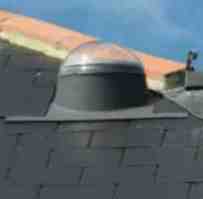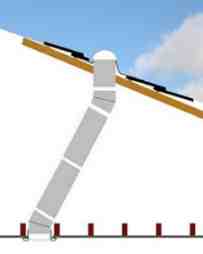Light Pipes
 In areas within a property where direct daylight is unavailable or insufficient, a number of techniques can be used to transmit natural daylight into the space rather than having to rely on artificial lighting.
In areas within a property where direct daylight is unavailable or insufficient, a number of techniques can be used to transmit natural daylight into the space rather than having to rely on artificial lighting.
The simplest of these is probably light pipes (confusingly also referred to as light tubes, light tunnels, sun pipes, sun scopes, solar light pipes, sky lights or daylight pipes), these consists of a roof (or wall) mounted plastic dome, connected by a pipe with a highly reflective internal surface to a diffuser mounted in the ceiling or wall.
Daylight enters the light pipe dome and is transmitted along the reflective tube by multiple reflections to emerge at the diffuser in the required area.
 The most obvious installation would be in a dark top floor room, stairway or landing with a loft space above. As light pipes do not require electricity, they are also ideal for lighting wet areas (such as bathrooms, showers or wet-rooms) or where there is no electricity supply (such as an isolated building).
The most obvious installation would be in a dark top floor room, stairway or landing with a loft space above. As light pipes do not require electricity, they are also ideal for lighting wet areas (such as bathrooms, showers or wet-rooms) or where there is no electricity supply (such as an isolated building).
The longer the tube and the more bends, the less effective the system will be, but some manufacturers claim a very low loss of performance for distances of up to over 10 metres.
Light pipes range in size, from about 20cm diameter upwards – the larger diameter light pipes are really for commercial premises and/or where longer tube lengths are required.
The smaller light pipes are very good from a security point of view as they would not allow easy entry to the building.
Light pipe systems are not cheap, but can be justified in terms of the quality of the light they provided and their nil running costs. Of course, light pipes only function during daylight so some artificial lighting will still be required at other times.
